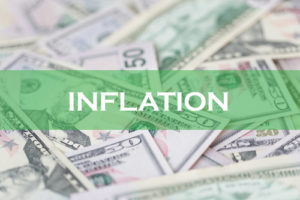 By Kevin Flanagan, WisdomTree Investments
By Kevin Flanagan, WisdomTree Investments
Special to the Financial Independence Hub
In a noticeable turn of events, one of the key talking points for the 2017 investment landscape has been the potential return of inflation. Indeed, only a little more than a year ago, a rather different take on this topic was dominating market discussion: deflation. However, since the results of the U.S. election became known, market participants began to shift their focus to what is being referred to as the “Trump Reflation Trade.”
Quite simply, the logic behind this “trade” is that fiscal stimulus will now take the baton from monetary policy and provide a newfound jolt to the economy, spurring potentially higher growth and elevated inflation readings, accordingly. For the most part, the financial markets appeared to buy into this line of reasoning, as the S&P 500 has risen +10% since Election Day while the U.S. Treasury (UST) 10-Year yield has climbed by about 65 basis points (bps) during this same time frame. Interestingly, broader commodity prices, as measured by the Thomson Reuters/CoreCommodity CRB Index, rose in the two-month period following the election to as high as +6.3% but have since reversed course and were basically unchanged as of this writing.
The most widely followed inflation gauge in the U.S. is the Consumer Price Index (CPI). This monthly report is released by the Bureau of Labor Statistics (BLS), with both the overall and core (excluding food and energy) readings receiving the most attention.
Inflation rise of 2.7% highest in 5 years
 The February CPI report revealed that overall inflation rose at a year-over-year rate of +2.7%, the highest in almost five years. This compares to the 2016 low point of +0.8% in July and the outright negative readings less than two years ago. Certainly, the rebound in energy prices from the levels witnessed 12 months ago played a role in this higher-than-expected reading, but perhaps more importantly from the Federal Reserve (Fed) perspective was the core measure, CPI minus food and energy, maintaining its recent upward pattern. Indeed, core CPI rose at an annual rate of +2.2% and has now posted a reading of +2.0% or higher for 16 consecutive months.
The February CPI report revealed that overall inflation rose at a year-over-year rate of +2.7%, the highest in almost five years. This compares to the 2016 low point of +0.8% in July and the outright negative readings less than two years ago. Certainly, the rebound in energy prices from the levels witnessed 12 months ago played a role in this higher-than-expected reading, but perhaps more importantly from the Federal Reserve (Fed) perspective was the core measure, CPI minus food and energy, maintaining its recent upward pattern. Indeed, core CPI rose at an annual rate of +2.2% and has now posted a reading of +2.0% or higher for 16 consecutive months.
Wage trends are another commonly watched inflation indicator, specifically the year-over-year levels for average hourly earnings (AHE). This barometer of wage performance can be found in the BLS’s monthly Employment Situation report. In the February release, AHE rose at an annual rate of +2.8%, continuing to reside at levels not seen since 2009.
Even the Fed has put itself squarely into the inflation discussion, as illustrated by its “pushed-up” rate hike at the March FOMC meeting. Certainly, one of the key reasons behind this latest tightening move was the fact that inflation was on the verge of hitting the Fed’s threshold of +2%. To provide some perspective, the Fed’s preferred measure for inflation is the price index for personal consumption expenditures, which itself has also been on an upward trajectory, and rose to +1.9%. The last time this measure hit the Fed’s target was 2012.
Conclusion
Elevated inflation expectations and actual inflation data will be watched more closely by the money and bond markets as we move forward. The turnaround in energy prices from the lows witnessed last year, the recent pullback in the U.S. dollar and less disinflation in key places such as China could all serve to support higher overall readings in the months ahead, while the recent upward trend in wages will also need to be monitored.
Against this backdrop, the breakeven inflation rate, or the difference between the yield on a nominal bond (such as the U.S. Treasury 10-Year note) and an inflation-linked or real yield bond with the same maturity (such as the 10-Year U.S. Treasury Inflation-Protected Securities or TIPS), will serve as a useful guide regarding inflation expectations. As of this writing, this rate has widened out to 2.01%, an increase from the 1.20% low reached in February of last year. However, this rate is still close to the 2.07% five-year mean and well below the peak of 2.64% during this time period.
Unless otherwise noted, all data is from Bloomberg as of March 20, 2017.
 Kevin Flanagan is WisdomTree’s Senior Fixed Income Strategist. In this role, he contributes to the asset allocation team, writes fixed income-related content and travels with the sales team, conducting client-facing meetings and providing expertise on WisdomTree’s existing and future bond ETFs. In addition, Kevin works closely with the fixed income team. Prior to joining WisdomTree, Kevin spent 30 years at Morgan Stanley, where he was most recently a Managing Director. Kevin has an MBA from Pace University’s Lubin Graduate School of Business, and a B.S in Finance from Fairfield University.
Kevin Flanagan is WisdomTree’s Senior Fixed Income Strategist. In this role, he contributes to the asset allocation team, writes fixed income-related content and travels with the sales team, conducting client-facing meetings and providing expertise on WisdomTree’s existing and future bond ETFs. In addition, Kevin works closely with the fixed income team. Prior to joining WisdomTree, Kevin spent 30 years at Morgan Stanley, where he was most recently a Managing Director. Kevin has an MBA from Pace University’s Lubin Graduate School of Business, and a B.S in Finance from Fairfield University.
Important Risks Related to this Article Fixed income investments are subject to interest rate risk; their value will normally decline as interest rates rise. In addition, when interest rates fall, income may decline. Fixed income investments are also subject to credit risk, the risk that the issuer of a bond will fail to pay interest and principal in a timely manner or that negative perceptions of the issuer’s ability to make such payments will cause the price of that bond to decline.
Disclosure: Commissions, management fees and expenses all may be associated with investing in WisdomTree ETFs. Please read the relevant prospectus before investing. WisdomTree ETFs are not guaranteed, their values change frequently and past performance may not be repeated. Past performance is not indicative of future results. This material contains the opinions of the author, which are subject to change, and should not to be considered or interpreted as a recommendation to participate in any particular trading strategy, or deemed to be an offer or sale of any investment product and it should not be relied on as such. There is no guarantee that any strategies discussed will work under all market conditions. This material represents an assessment of the market environment at a specific time and is not intended to be a forecast of future events or a guarantee of future results. This material should not be relied upon as research or investment advice regarding any security in particular. The user of this information assumes the entire risk of any use made of the information provided herein. Neither WisdomTree nor its affiliates provide tax or legal advice. Investors seeking tax or legal advice should consult their tax or legal advisor. Unless expressly stated otherwise the opinions, interpretations or findings expressed herein do not necessarily represent the views of WisdomTree or any of its affiliates. “WisdomTree” is a marketing name used by WisdomTree Investments, Inc. and its affiliates globally. WisdomTree Asset Management Canada, Inc., a wholly-owned subsidiary of WisdomTree Investments, Inc., is the manager and trustee of the WisdomTree ETFs listed for trading on the Toronto Stock Exchange.

